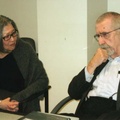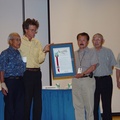A remarkable journey began as a handful of Nisei survivors gathered on the wind-swept plains of Bismarck, North Dakota, at the site of what was once Ft. Lincoln, a World War II-era Department of Justice prison.
What made this weekend so memorable was that the program, hosted by Native Americans, was one of those welcome occasions where a part of history that is little known within the Japanese American community was acknowledged and validated.
These former inmates at Tule Lake Segregation Center—who renounced their citizenship and were sent to the DOJ internment camp in Bismarck, ND—participated in an educational and historical program sponsored by the Native American residential college and trade school that currently occupies the former Ft. Lincoln site. Approximately 150 Native Americans, and German American and Japanese American internees attended the October 4-5, 2003 program hosted by the United Tribes Technical College (UTTC).
Ft. Lincoln was among the handful of DOJ camps where several thousand Issei, Nisei and Kibei were unjustly interned during World War II as “enemy aliens.” Little is known about their experiences in these DOJ camps—places like Crystal City, Missoula, Santa Fe and Bismarck—because most of those imprisoned avoided telling their families or the Japanese American community about that experience.
Breaking the Silence
“Trauma leads to silence,” explained Satsuki Ina, a Sacramento-based psychotherapist, whose father, Itaru Ina, was removed from Tule Lake and interned at Ft. Lincoln. Ina produced Children of the Camps, a ground-breaking film concerning the emotional trauma and scars inflicted on Japanese Americans by the wartime incarceration. Currently, she is at work on a film, From a Silk Cocoon, based on her parents’ correspondence while her father was imprisoned in Ft. Lincoln in Bismarck, ND.
Much of the problem for her parents and others who were sent to the Tule Lake Segregation Center, said Ina, began with the divisive loyal questionnaire.
“Those who answered ‘no-no’ were labeled ‘disloyal’ and were made to feel as though they did something wrong, that they were bad people. Their experience was not validated or perceived as worthy,” says Ina. “The reality was that they were in a difficult situation trying to deal with practical human needs and to take care of their families.”
For most, ‘no-no’ answers were statements of protest about their unjust treatment, rather than true statements disavowing loyalty,” she continued. “Protests about the violation of constitutional and human rights were confused with disloyalty.”
“The voice of JACL said to be loyal,” Ina said, noting how Japanese Americans were urged to identify with their powerful oppressors, somewhat like the phenomena known as the Stockholm Syndrome in which the captive begins to identify with the goals of their captor. “But, what did it mean to be loyal?” she questioned. “Loyal to what? Did it mean to be like the JACL and be disloyal to our own people—to turn people in—to collaborate with the government?”
Imprisoned Japanese Americans, like other powerless victims, internalized the perpetrator’s accusations, Ina explained. The ones labeled disloyal were essentially banished—a deeply humiliating consequence of being accused of disloyalty. “Issues of loyalty then served to divert attention away from the injustice of the incarceration.”
Snow Country Prison
The “no-nos” were sent to the poorly managed, conflict-ridden Tule Lake segregation center to contemplate a future in a country that did not want them. The U.S. Congress, responding to the requests of Attorney General Biddle and nativist and racist groups like the Native Sons of the Golden West, passed Public Law 405, that permitted an American citizen to renounce their citizenship. This law, known as the Renunciation Act of 1944, set the stage for thousands of Japanese Americans to renounce their second-class citizenship, becoming enemy aliens who could be deported with little difficulty.
The 5,589 Japanese Americans who renounced had widely varying reasons for giving up their birthright. Some believed that renouncing would help keep their family together in Tule Lake and that they could reverse that choice when the war ended. When the Selective Service began drafting inmates, the number of renunciations increased, a way to refuse service and to protest incarceration and treatment as second-class citizens. Others renounced to demonstrate ethnic pride in being “true Japanese.” For people with no legal forums available to them, renouncing became a method to express anger and to protest their treatment.
“For most renunciants, including my parents, they suffered not a crisis of loyalty, but a crisis of faith…in their government,” says Ina. Both Ina’s mother and father renounced their U.S. citizenship.
“My parents decided the only way to survive and have their children respected and valued
was to return to Japan,” she said of her Kibei parents’ decision to leave the U.S. “They decided their only hope was to renounce and go to Japan.”
They were not alone in that wrenching decision. In Tule Lake, approximately half of those who were U.S. citizens renounced their allegiance to the country that rejected and imprisoned them. Once those renunciations took place, members of Tule Lake’s activist, pro-Japan groups were sent to DOJ internment camps in Santa Fe and Bismarck. Ina’s father was among a group of several hundred Nisei and Kibei taken from their families and interned at Bismarck as an “enemy alien.”
Throughout his internment in Bismarck, Satsuki Ina’s father, Itaru Ina, wrote haiku and maintained correspondence with his wife and two small children who remained in Tule Lake. Their correspondence eluded DOJ censors only because their letters were concealed, sewn into pockets and waistbands of clothing that Itaru Ina sent to his wife to be mended.
Itaru Ina’s haiku, written during his internment, form a powerful element of the exhibit, Snow Country Prison, that opened as part the weekend program at UTTC. It tells the story of Ft. Lincoln using World War II-era photographs, artifacts, and the haiku poetry written by Itaru Ina while imprisoned at Bismarck. The exhibit was developed by the North Dakota Museum of Art and will travel through North Dakota and Minnesota in upcoming months. Plans are being made to bring the exhibit to the West Coast.
Reports from relatives in Japan telling them not to come, warning of devastation and lack of food and housing, led to desperate efforts to reverse their decision to go to Japan after the war. Through the decades-long efforts of San Francisco attorney Wayne Collins, Ina’s parents and over 5,000 others regained their U.S. citizenship. Yet, there was a lingering sense of shame.
“If you live long enough behind a barbed wire fence, you start to believe you are bad and deserve to be there.” You develop a “fence-sickness” she says of the psychological trauma of being imprisoned.
The program ended with a healing ceremony performed by a Lakota medicine man. In symbolic gestures, he wiped away the tears of each internee and endowed each with courage and strength of the eagle.
In the field of white snow,
I starve for the love
of my own people.—Itaru Ina
Yuki shiroki
No ni nikushin no
Ai ni ue
*This article was originally published in the Nichibei Times in January 2004.
© 2004 Barbara Takei





